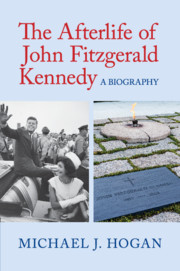Book contents
- Frontmatter
- Dedication
- Contents
- Acknowledgments
- List of Abbreviations
- 1 The Afterlife of John Fitzgerald Kennedy: An Introduction
- 2 All the World's a Stage: Constructing Kennedy
- 3 From History to Memory: Assassination and the Making of a Sacred Symbol
- 4 Ritual and Remembrance: Cultural Trauma, Collective Memory, and the Funeral of John Fitzgerald Kennedy
- 5 In Death There Is Life: Monuments of Paper and Pen
- 6 In Death There Is Life: Monuments of Glass, Steel, and Stone
- 7 The Memory Wars: Contesting Kennedy
- 8 Gone but Not Forgotten: History, Memory, and Nostalgia
- Notes
- Selected Bibliography
- Index
1 - The Afterlife of John Fitzgerald Kennedy: An Introduction
Published online by Cambridge University Press: 23 March 2017
- Frontmatter
- Dedication
- Contents
- Acknowledgments
- List of Abbreviations
- 1 The Afterlife of John Fitzgerald Kennedy: An Introduction
- 2 All the World's a Stage: Constructing Kennedy
- 3 From History to Memory: Assassination and the Making of a Sacred Symbol
- 4 Ritual and Remembrance: Cultural Trauma, Collective Memory, and the Funeral of John Fitzgerald Kennedy
- 5 In Death There Is Life: Monuments of Paper and Pen
- 6 In Death There Is Life: Monuments of Glass, Steel, and Stone
- 7 The Memory Wars: Contesting Kennedy
- 8 Gone but Not Forgotten: History, Memory, and Nostalgia
- Notes
- Selected Bibliography
- Index
Summary
The president woke up in a good mood on November 22, 1963. His back hurt more than usual, so he reinforced the corset he normally wore with a bandage-wrap for extra support. The discomfort did not darken his spirit, however; nor did the news of continued wrangling among leaders of the Democratic Party in Texas, particularly a squabble between conservative Governor John Connally and liberal Senator Ralph Yarborough that even Vice President Lyndon Johnson had been unable or unwilling to resolve. Despite this annoyance and his aching back, the president seemed more impressed by the large crowds and thunderous welcome that he and his wife had experienced during the first leg of their Texas trip. Even First Lady Jacqueline Kennedy, who normally disliked campaigning, was thrilled by their reception, and she and her husband had no reason to expect anything less from the day ahead. On the contrary, another enthusiastic crowd was already forming in the street below their hotel window. “I'll go anywhere with you,” said the first lady, as she watched a smile flash across the handsome face of her husband.
Nor was their mood darkened by a newspaper advertisement just published in the conservative Dallas Morning News. It began with sarcastic words welcoming President John F. Kennedy to the Lone Star State, but then launched a scurrilous attack, concealed in a series of leading questions, on the president's liberal policies at home and his supposedly soft stand on communism abroad. The ad revealed a degree of hostility toward the Kennedy administration that had been building for some time. Right-wing groups had physically and verbally assaulted Vice President Johnson and his wife when they campaigned in the state three years earlier, and similar groups had roughed up UN ambassador Adlai Stevenson during his visit to Dallas only a month before the president arrived. Stevenson was the darling of the liberal wing of the Democratic Party, a status that did not endear him to the increasingly conservative voters of Texas, who also viewed Johnson, a Texas native, as a traitor to his state for supporting the president's progressive agenda, especially on civil rights for African Americans.
All this was well known to Kennedy, as was the politics of the Dallas Morning News and its publisher and board chairman, E. M. Dealey.
- Type
- Chapter
- Information
- The Afterlife of John Fitzgerald KennedyA Biography, pp. 1 - 15Publisher: Cambridge University PressPrint publication year: 2017

